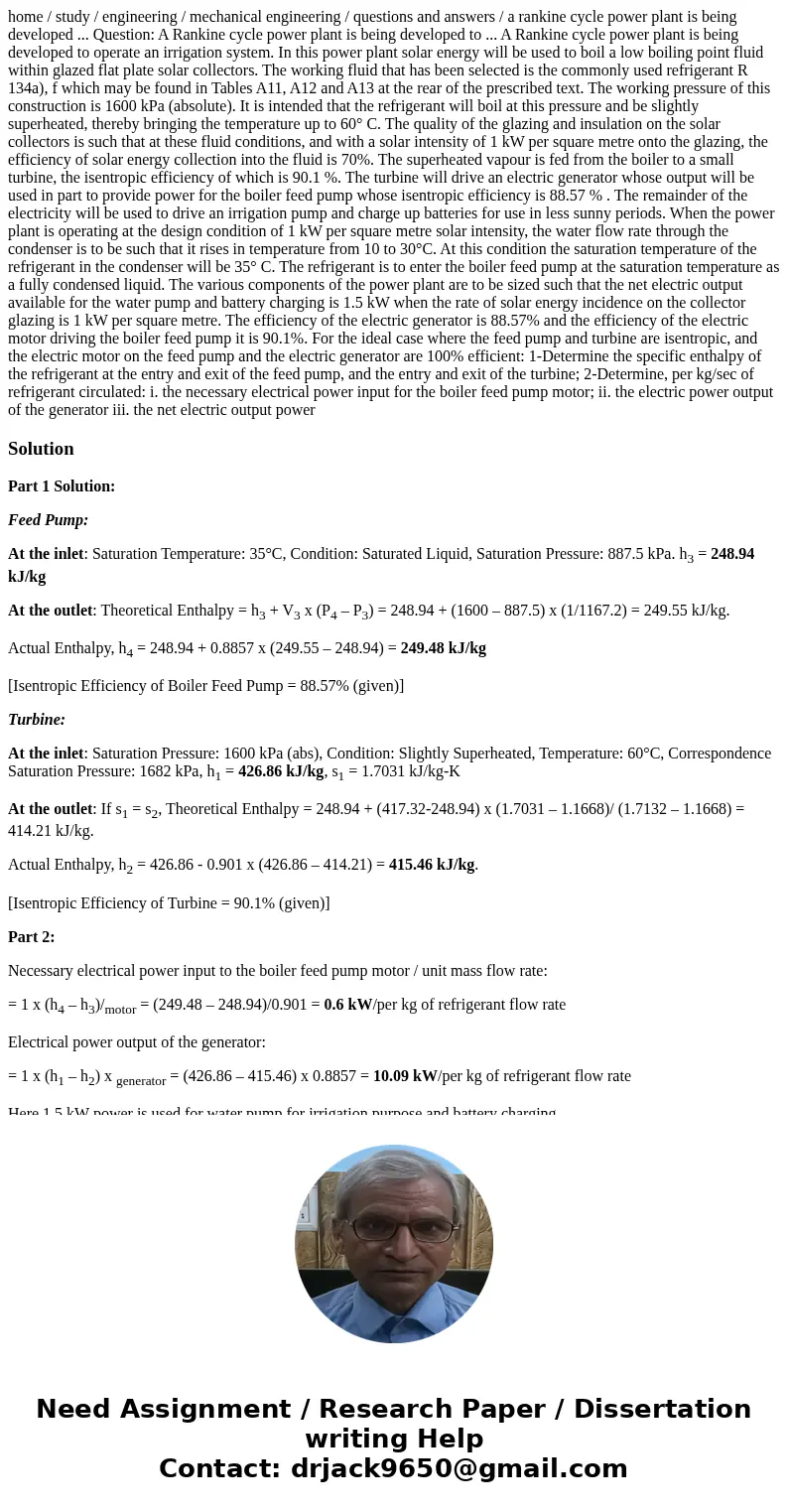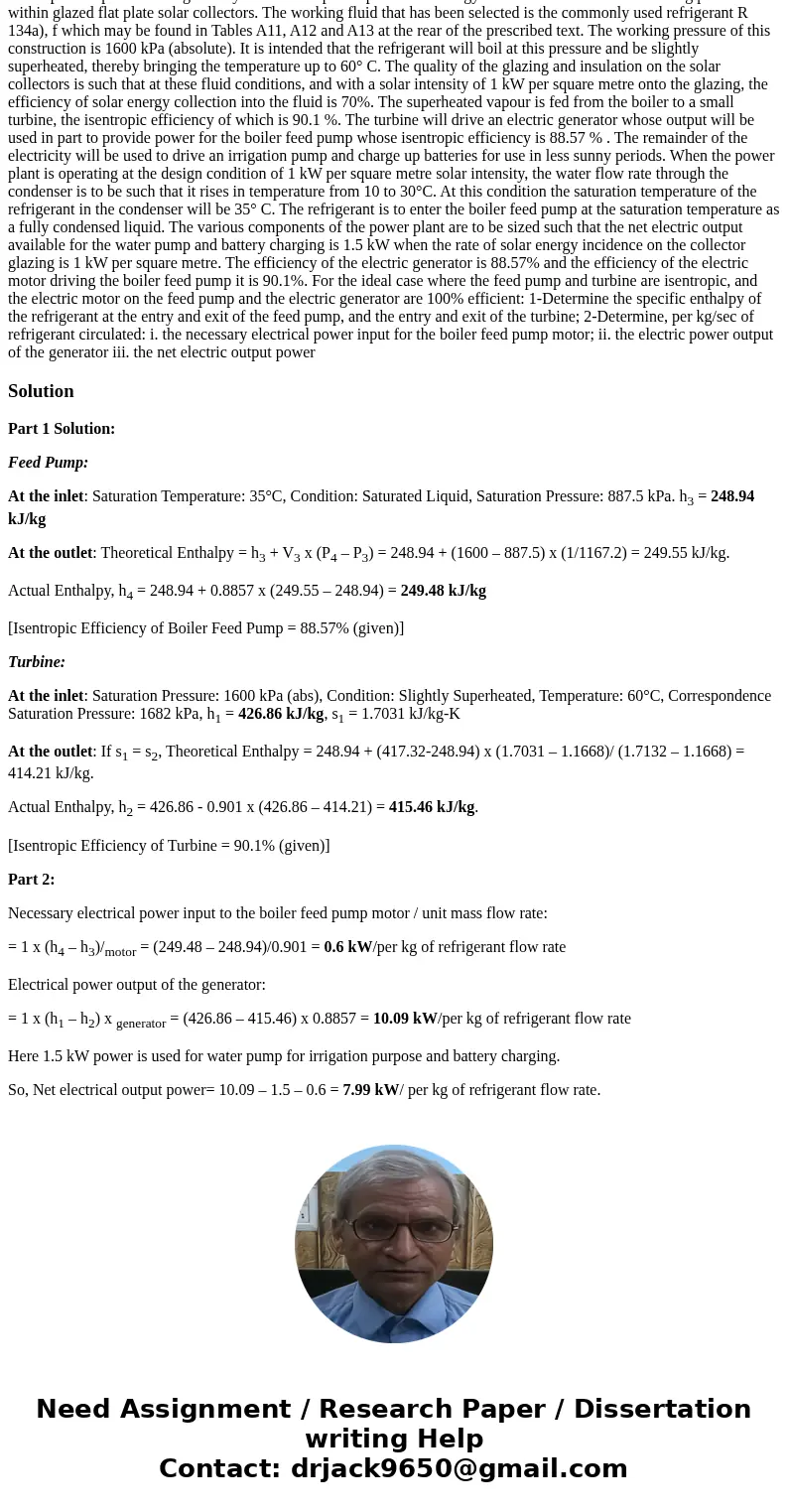home study engineering mechanical engineering questions
home / study / engineering / mechanical engineering / questions and answers / a rankine cycle power plant is being developed ... Question: A Rankine cycle power plant is being developed to ... A Rankine cycle power plant is being developed to operate an irrigation system. In this power plant solar energy will be used to boil a low boiling point fluid within glazed flat plate solar collectors. The working fluid that has been selected is the commonly used refrigerant R 134a), f which may be found in Tables A11, A12 and A13 at the rear of the prescribed text. The working pressure of this construction is 1600 kPa (absolute). It is intended that the refrigerant will boil at this pressure and be slightly superheated, thereby bringing the temperature up to 60° C. The quality of the glazing and insulation on the solar collectors is such that at these fluid conditions, and with a solar intensity of 1 kW per square metre onto the glazing, the efficiency of solar energy collection into the fluid is 70%. The superheated vapour is fed from the boiler to a small turbine, the isentropic efficiency of which is 90.1 %. The turbine will drive an electric generator whose output will be used in part to provide power for the boiler feed pump whose isentropic efficiency is 88.57 % . The remainder of the electricity will be used to drive an irrigation pump and charge up batteries for use in less sunny periods. When the power plant is operating at the design condition of 1 kW per square metre solar intensity, the water flow rate through the condenser is to be such that it rises in temperature from 10 to 30°C. At this condition the saturation temperature of the refrigerant in the condenser will be 35° C. The refrigerant is to enter the boiler feed pump at the saturation temperature as a fully condensed liquid. The various components of the power plant are to be sized such that the net electric output available for the water pump and battery charging is 1.5 kW when the rate of solar energy incidence on the collector glazing is 1 kW per square metre. The efficiency of the electric generator is 88.57% and the efficiency of the electric motor driving the boiler feed pump it is 90.1%. For the ideal case where the feed pump and turbine are isentropic, and the electric motor on the feed pump and the electric generator are 100% efficient: 1-Determine the specific enthalpy of the refrigerant at the entry and exit of the feed pump, and the entry and exit of the turbine; 2-Determine, per kg/sec of refrigerant circulated: i. the necessary electrical power input for the boiler feed pump motor; ii. the electric power output of the generator iii. the net electric output power
Solution
Part 1 Solution:
Feed Pump:
At the inlet: Saturation Temperature: 35°C, Condition: Saturated Liquid, Saturation Pressure: 887.5 kPa. h3 = 248.94 kJ/kg
At the outlet: Theoretical Enthalpy = h3 + V3 x (P4 – P3) = 248.94 + (1600 – 887.5) x (1/1167.2) = 249.55 kJ/kg.
Actual Enthalpy, h4 = 248.94 + 0.8857 x (249.55 – 248.94) = 249.48 kJ/kg
[Isentropic Efficiency of Boiler Feed Pump = 88.57% (given)]
Turbine:
At the inlet: Saturation Pressure: 1600 kPa (abs), Condition: Slightly Superheated, Temperature: 60°C, Correspondence Saturation Pressure: 1682 kPa, h1 = 426.86 kJ/kg, s1 = 1.7031 kJ/kg-K
At the outlet: If s1 = s2, Theoretical Enthalpy = 248.94 + (417.32-248.94) x (1.7031 – 1.1668)/ (1.7132 – 1.1668) = 414.21 kJ/kg.
Actual Enthalpy, h2 = 426.86 - 0.901 x (426.86 – 414.21) = 415.46 kJ/kg.
[Isentropic Efficiency of Turbine = 90.1% (given)]
Part 2:
Necessary electrical power input to the boiler feed pump motor / unit mass flow rate:
= 1 x (h4 – h3)/motor = (249.48 – 248.94)/0.901 = 0.6 kW/per kg of refrigerant flow rate
Electrical power output of the generator:
= 1 x (h1 – h2) x generator = (426.86 – 415.46) x 0.8857 = 10.09 kW/per kg of refrigerant flow rate
Here 1.5 kW power is used for water pump for irrigation purpose and battery charging.
So, Net electrical output power= 10.09 – 1.5 – 0.6 = 7.99 kW/ per kg of refrigerant flow rate.


 Homework Sourse
Homework Sourse